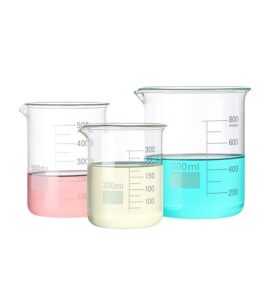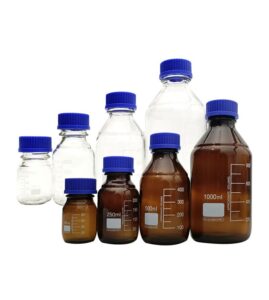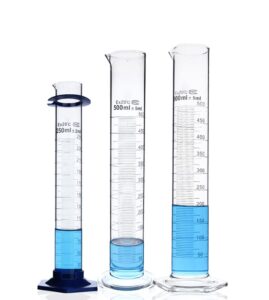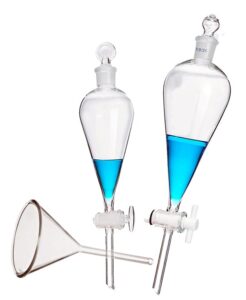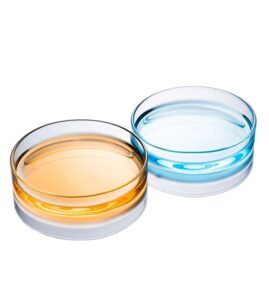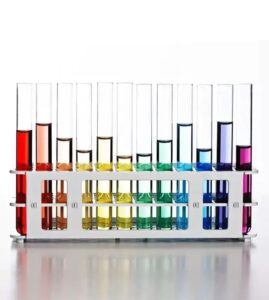In the intricate dance of scientific discovery, laboratory glassware plays a pivotal role, holding the substances that fizz, react, and transform under the researcher’s watchful eye. But amidst this ballet of bubbling beakers and swirling flasks, a critical question arises: Which glassware can safely dance with the flames, and which must watch from the sidelines?
Choosing the right glassware for heating purposes is not merely a technical decision—it’s a safeguard against accidents, ensuring that experiments run smoothly and safely. This guide aims to demystify the world of heat-safe laboratory glassware, providing you with the knowledge to select the right tools for your next heated experiment.
Dive into this essential exploration of laboratory glassware, where safety meets science in the quest for knowledge.
Understanding the Thermal Resilience of Laboratory Glass
The foundation of safely applying heat in a laboratory setting begins with an understanding of the materials at your disposal. Primarily, laboratory glassware is manufactured from two types of glass: borosilicate and soda-lime glass. Borosilicate glass, renowned for its remarkable resistance to thermal shock and chemical corrosion, is the material of choice for applications involving sudden temperature changes or exposure to aggressive chemicals. Soda-lime glass, although more common and less expensive, does not offer the same level of thermal resilience and is more prone to cracking under thermal stress.
Comparative Analysis of Borosilicate and Soda-Lime Glassware in Laboratory Heat Applications
The resilience and functionality of laboratory glassware under thermal conditions are paramount for successful scientific experimentation. This distinction is primarily evident between two prevalent materials: borosilicate and soda-lime glass. Below is a detailed comparison highlighting their differences in thermal elasticity and specific laboratory applications.
Thermal Resilience and Applications of Borosilicate vs. Soda-Lime Laboratory Glassware
| Material Type | Thermal Shock Resistance | Chemical Corrosion Resistance | Common Laboratory Applications |
|---|---|---|---|
| Borosilicate Glass | High resistance to thermal shock, capable of withstanding rapid temperature changes without cracking | High resistance to chemical corrosion, making it suitable for handling acidic or basic substances | Erlenmeyer flasks, Petri dishes, test tubes, and beakers used in chemical reactions and processes involving high temperatures or corrosive substances |
| Soda-Lime Glass | Lower resistance to thermal shock, prone to cracking under rapid temperature changes | Moderate resistance to chemical corrosion, not recommended for highly corrosive substances | Simple storage containers, standard pipettes, and slides where temperature changes are minimal and chemical aggression is low |
Understanding these differences is essential for selecting the appropriate glassware type to ensure safety and integrity in laboratory experiments involving heat and chemical exposure. Choosing the right material not only contributes to the success of scientific endeavors but also significantly minimizes the risk of accidents and material damage.
Direct Heat Applications: Selecting the Right Glassware
Certain laboratory procedures necessitate the direct application of heat to glassware. When selecting glassware for such applications, it’s essential to choose items specifically designed to withstand direct heat:
- Test Tubes: Ideal for conducting reactions on a small scale, test tubes made from borosilicate glass can be heated directly over a Bunsen burner flame or on a hot plate.
- Crucibles: Used for heating substances to high temperatures, crucibles can endure direct heat when composed of the right material, such as porcelain or borosilicate glass.
- Evaporating Dishes: These dishes are designed to concentrate solutions by evaporating solvents, capable of withstanding direct heating on a hot plate.
- Combustion Spoons: Utilized for burning or combusting samples, these spoons are made from materials that can directly contact flames without damage.
The Art of Indirect Heating
For glassware not suited for direct flame or extreme heat sources, indirect heating methods are a must. This approach involves using devices that distribute heat evenly and gently, such as:
- Water Baths: Ideal for heating substances in beakers or flasks, water baths provide uniform heat distribution and prevent glassware from overheating.
- Heating Mantles: Perfect for round-bottom flasks, heating mantles deliver heat without direct contact, minimizing the risk of thermal shock.
- Sand Baths: Offering a stable and uniform heating surface, sand baths are excellent for heating irregularly shaped or flat-bottomed glassware.
Comprehensive Guide to Heating Laboratory Glassware: Direct, Indirect, and Non-Heat-Safe Categories
| Glassware Type | Heating Method | Auxiliary Equipment | Safety Precautions |
|---|---|---|---|
| Direct Heat-Safe | |||
| Test Tubes (Borosilicate) | Direct | Bunsen Burner, Hot Plate | Use heat-resistant gloves; Gradually introduce heat |
| Crucibles (Borosilicate/Porcelain) | Direct | Bunsen Burner, Muffle Furnace | Ensure even heating to avoid thermal stress |
| Evaporating Dishes (Borosilicate) | Direct | Hot Plate, Bunsen Burner | Avoid adding cold liquids to a heated dish |
| Combustion Spoons | Direct | Bunsen Burner | Keep at a safe distance from flammable materials |
| Indirect Heat-Safe | |||
| Beakers (Borosilicate) | Indirect | Water Bath, Sand Bath | Prevent water from boiling dry in a water bath |
| Flasks (Borosilicate) | Indirect | Heating Mantle, Water Bath | Clamp flasks securely when using heating mantles |
| Round-Bottom Flasks (Borosilicate) | Indirect | Heating Mantle, Sand Bath | Use a suitable adapter for flask stability on sand baths |
| Non-Heat-Safe | |||
| Graduated Cylinders (Soda-Lime) | None | N/A | Use alternative methods for heating liquids |
| Pipettes (Soda-Lime) | None | N/A | Pre-warm liquids if necessary before measuring |
| Standard Slides (Soda-Lime) | None | N/A | Avoid thermal exposure; room temperature use only |
Navigating Common Heating Pitfalls
A successful experiment is not just about knowing which glassware can be heated, but also about understanding common mistakes to avoid:
- Mistaking Glassware Types: Not all glassware is created equal. Using volumetric instruments like graduated cylinders or volumetric flasks for direct heating can lead to breakage and inaccurate measurements due to thermal expansion.
- Uneven Heating: Directly placing glassware on electric heaters without an intermediary can cause hot spots and uneven heating, risking thermal stress and glass breakage.
Ensuring Glassware Integrity and Safety
Maintaining the integrity of your laboratory glassware and ensuring safety during heat applications involves several best practices:
- Gradual Heating/Cooling: To minimize thermal stress, slowly increase and decrease temperatures when heating or cooling glassware.
- Regular Inspections: Before any heat application, inspect glassware for cracks, chips, or scratches that could compromise its structural integrity under thermal stress.
- Proper Cleaning: Residual chemicals can react unpredictably when heated. Ensure glassware is thoroughly cleaned and dried before applying heat.
Troubleshooting Common Issues When Heating Glassware
Despite the best preparations, researchers may encounter issues when applying heat to laboratory glassware. Here are solutions to some of the most common problems:
Problem: Glassware Breakage During Heating
Solution: Always use borosilicate glass for applications involving significant temperature changes. Ensure a gradual increase and decrease in temperature to avoid thermal shock. Using a heat diffuser or opting for indirect heating methods can also reduce the risk of breakage.
Problem: Residue Buildup in Glassware
Solution: Persistent residue can interfere with heat transfer and lead to overheating or contamination. Regularly clean glassware using appropriate solvents and cleaning agents. For stubborn residues, consider using ultrasonic baths or specialized cleaning solutions designed for laboratory use.
Problem: Uneven Heating
Solution: Uneven heating can lead to inconsistent experimental results. To combat this, use indirect heating methods like water baths, sand baths, or heating mantles, which provide more uniform heat distribution. Stirring the contents continuously, if possible, can also promote even heating and prevent hot spots.
Implementing Safety Protocols for Heating Laboratory Glassware
Adhering to stringent safety protocols is paramount when heating laboratory glassware. Here are key safety measures that should be integrated into laboratory practices:
Use of Fume Hoods
When heating volatile or hazardous chemicals, always use a fume hood to ensure proper ventilation. This not only protects the user from inhaling toxic fumes but also reduces the risk of fire or explosion.
Proper Ventilation
Even in the absence of toxic fumes, ensuring that the laboratory is well-ventilated during heating experiments is crucial. This helps dissipate heat and maintain a safe working environment.
Emergency Procedures
Laboratories should have clear emergency procedures for dealing with thermal shock, glassware breakage, or chemical spills. This includes having fire extinguishers, safety showers, and eye wash stations readily accessible, along with training on how to use them effectively.
Personal Protective Equipment (PPE)
Wearing the appropriate PPE, such as lab coats, safety goggles, and heat-resistant gloves, is essential to protect against burns, splashes, and other hazards associated with heating glassware.
Regulatory Standards and Certifications: Ensuring Compliance and Reliability
In the realm of scientific research, the integrity of laboratory glassware is not just a matter of material choice but also of adhering to established regulatory standards and certifications. These benchmarks are crucial for ensuring that glassware can safely withstand the conditions it will be subjected to, especially when heat is involved. Organizations such as the American Society for Testing and Materials (ASTM) and the International Organization for Standardization (ISO) set these standards to specify the requirements for laboratory glassware, including its thermal resistance, chemical durability, and safety features.
For researchers and laboratory technicians, familiarity with these standards is paramount. Compliance with ASTM E438 for borosilicate glassware, for instance, ensures that the glassware has been rigorously tested for use in high-temperature applications. Similarly, ISO certifications can attest to the quality and safety of the glassware on an international level. By selecting glassware that meets these stringent standards, laboratories can mitigate risks, enhance the reliability of their experiments, and ensure the safety of their personnel.
Supplier and Brand Recommendations: Making Informed Choices
Navigating the marketplace for laboratory glassware can be daunting, given the plethora of suppliers and brands available. However, making informed choices becomes easier when you know what to look for in terms of quality, reliability, and compliance with regulatory standards. Brands like Corning, Duran, Kimble, and Winson are renowned for their high-quality borosilicate glassware, offering products that are not only durable and heat-safe but also compliant with international standards.
When selecting a supplier or brand for your laboratory’s glassware needs, consider the following criteria:
- Quality Assurance: Look for suppliers that provide transparent information about their quality control processes and adherence to regulatory standards.
- Product Range: Opt for brands that offer a comprehensive range of glassware suitable for a variety of heating applications, ensuring that you can source all your needs from a single supplier.
- Customer Support: Reliable suppliers offer excellent customer support, including guidance on selecting the right glassware for your specific applications and advice on maintenance and safety.
- Reputation: Research the brand’s reputation within the scientific community. Recommendations from peers, user reviews, and case studies can provide valuable insights into the quality and reliability of the glassware.
Advanced Heating Techniques in Laboratory Settings
Moving beyond the basic methods of heating laboratory glassware opens a new realm of possibilities for conducting experiments with precision and control. Here are some advanced heating techniques and the types of glassware they involve:
Oil Baths
An oil bath is a preferred method for uniform heating over a wide range of temperatures. By immersing the bottom of a flask in a bath of heated oil, researchers can achieve precise temperature control, ideal for reactions requiring steady heat. Glassware used in oil baths should be borosilicate due to its thermal stability.
Microwave Heating
Microwave heating has gained popularity in organic synthesis for its ability to dramatically reduce reaction times and improve yields. Specialized microwave-safe glassware is required for this technique, designed to withstand rapid heating and prevent pressure buildup.
Reflux Condensers
For reactions that need to be heated under reflux, using a reflux condenser attached to a round-bottom flask ensures that volatile components are condensed and returned to the reaction mixture. This setup typically involves borosilicate glassware to withstand the continuous heating cycle.
Each of these advanced techniques requires a thorough understanding of the specific glassware’s heat tolerances and compatibility to ensure successful and safe experimentation.
Conclusion: Mastering the Art of Heat-Safe Laboratory Glassware
Understanding the properties, applications, and limitations of heat-safe laboratory glassware is essential for conducting experiments safely and effectively. Equip yourself with the knowledge encapsulated here, and embark on a journey of discovery with confidence. Embrace the power of informed decisions, elevate your experiments with precision, and safeguard your scientific endeavors. Let this be your beacon as you navigate the complexities of laboratory heating, ensuring every step you take is grounded in safety and excellence. Forge ahead, innovate responsibly, and unlock the full potential of your research.


